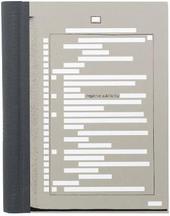
|
Negative Publicity: Artefacts of Extraordinary Rendition
Spiral bound
Main Details
| Title |
Negative Publicity: Artefacts of Extraordinary Rendition
|
| Authors and Contributors |
By (author) Edmund Clark
|
|
By (author) Crofton Black
|
|
By (author) Eyal Weizman
|
| Physical Properties |
| Format:Spiral bound | | Pages:316 | | Dimensions(mm): Height 295,Width 215 |
|
| Category/Genre | Individual photographers
Photographs: collections |
|---|
| ISBN/Barcode |
9781597113519
|
| Classifications | Dewey:779.9355 |
|---|
| Audience | |
|---|
| Illustrations |
Illustrated in colour and black and white throughout
|
|
Publishing Details |
| Publisher |
Aperture
|
| Imprint |
Aperture
|
| Publication Date |
1 February 2016 |
| Publication Country |
United States
|
Description
British photographer Edmund Clark and counter-terrorism investigator Crofton Black have assembled photographs and documents that confront the nature of contemporary warfare and the invisible mechanisms of state control. From George W. Bush's 2001 declaration of the "war on terror" until 2008, an unknown number of people disappeared into a network of secret prisons organized by the U.S. Central Intelligence Agency-transfers without legal process known as extraordinary renditions. No public records were kept as detainees were shuttled all over the globe. Some were eventually sent to Guantanamo Bay or released without charge, while others remain unaccounted for. The paper trail assembled in this volume shows these activities via the weak points of business accountability: invoices, documents of incorporation, and billing reconciliations produced by the small-town American businesses enlisted in detainee transportation. Clark has traveled worldwide to photograph former detention sites, detainees' homes, and government locations. He and Black recreate the network that links CIA "black sites," and evoke ideas of opacity, surface, and testimony in relation to this process-a system hidden in plain sight. Negative Publicity: Artefacts of Extraordinary Rendition, copublished with the Magnum Foundation, its creation supported by Magnum Foundation's Emergency Fund, raises fundamental questions about the accountability and complicity of our governments, and the erosion of our most basic civil rights.
Author Biography
Edmund Clark is an award-winning photographer whose work links history, politics, and representation. His series Guantanamo: If the Light Goes Out (2010), Letters to Omar (2010), and Control Order House (2012) engage with state censorship to explore hidden experiences and spaces of control and incarceration in the global 'war on terror.' His work The Mountains of Majeed (2014) reflects on the end of Operation Enduring Freedom in Afghanistan, the longest war in American history. Clark has received worldwide recognition for his work, including the Royal Photographic Society Hood Medal for outstanding photography for public service and the British Journal of Photography International Photography Award, as well as being shortlisted for the Prix Pictet and the W. Eugene Smith Award. His work has been acquired for public collections in Europe and America. He teaches at the University of the Arts, London. Crofton Black has spent over five years carrying out in-depth international investigations into counterterrorism tactics on behalf of the human rights group Reprieve, the Bureau of Investigative Journalism, and other organizations. He has a doctorate of philosophy from the University of London on the topic of early modern hermeneutics and was formerly an Alexander von Humboldt Fellow at the Freie Universitat Berlin. Eyal Weizman is Professor of Spatial and Visual Cultures at Goldsmiths, University of London, where he directs the Centre for Research Architecture and the European Research Council funded project Forensic Architecture. He is also a founder member of the collective Decolonizing Architecture Art Residency (DAAR) in Bethlehem, Palestine. He is the author of Hollow Land, among other titles. He lives in London. Ben Weaver is a graphic designer, art director of The Wire magazine, and cofounder and publisher of Here Press.
|